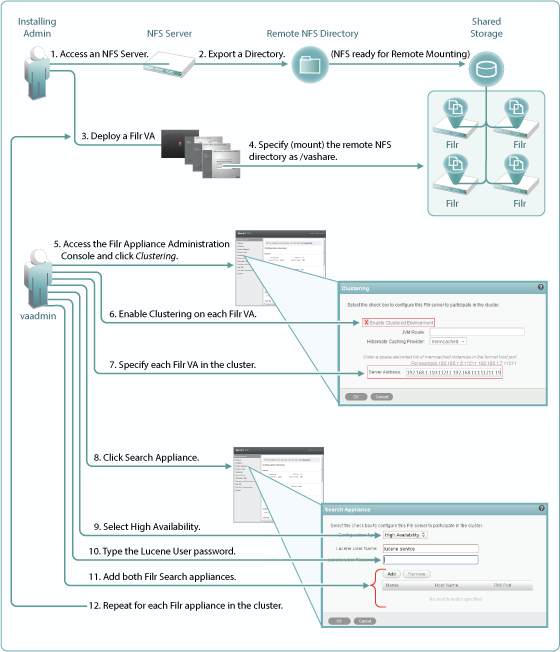1.4 Planning a Multi-Server (Clustered) Filr Configuration
1.4.1 Components of a Clustered Environment
In a large installation, the Filr components separately. Following are the minimum requirements:
Exported Directory on NFS File Server: You must export a directory on an NFS file server (SLES or OES; Windows is not supported) and configure each clustered Filr appliance to mount it as shared storage (/vashare). For more information, see Section 2.1, Installing the Filr Appliance.
Filr Appliance: You can run multiple instances of the Filr appliance, which allows the Filr system to handle more users. For information about installing multiple Filr appliances, see Section 2.1, Installing the Filr Appliance.
Lucene Index Server Appliance: Novell recommends running two instances of the Lucene index server appliance, which provides fault tolerance or backup in the event that one index server fails. Load balancing is not supported between index servers. For information about installing multiple Lucene index server appliances, see Section 2.2.1, Installing the Search Index Appliance.
MySQL Database Appliance: You can run only one instance of the MySQL database appliance. For information about installing a MySQL database appliance, see Section 2.2.2, Installing the MySQL Database Appliance.
For information about possible configuration setups and how many users are appropriate for each setup, see Section 1.8, Recommended Hardware Configurations Based on System Performance.
1.4.2 Filr Clustering
Filr clustering involves two or more Filr VAs sharing the same NFS data storage location (/vashare). Basic steps for setting up Filr clustering are included in Figure 1-1.
Figure 1-1 Clustered Filr VAs

For more information about clustering, see Changing Clustering Configuration Settings in the Novell Filr Installation and Configuration Guide.
1.4.3 Setting Aside a Filr Appliance for Re-Indexing and Net Folder Synchronization in a Clustered Environment
In a clustered environment, it is a good idea to set aside a single Filr appliance to perform specific resource-intensive tasks.
You can use the standalone Filr appliance to manually perform each of the following tasks:
-
Synchronizing a Net Folder
-
Re-indexing the search index
To set aside a Filr appliance and to use it to perform resource-intensive tasks:
-
Configure the load balancer to load balance between all the Filr appliances in the cluster except for the Filr appliance that you want to set aside for indexing or Net Folder synchronization.
For more information about load balancing in Filr, see Section A.0, Configuring Apache as a Load Balancer.
-
Access the standalone Filr appliance from a web browser by navigating to the URL of that particular Filr appliance.
Because the standalone appliance is separate from the load balancer, you must access it directly in order to use it for re-indexing or for Net Folder synchronization. By accessing the appliance directly, you force the process to originate from this particular appliance.
-
Rebuild the search index as described in
Rebuilding the Search Index with Multiple Index Servers
in the Novell Filr 1.0.1 Administration Guide.or
Manually synchronize a Net Folder, as described in
Synchronizing a Net Folder
in the Novell Filr 1.0.1 Administration Guide.
1.4.4 Clustering Limitations
In a clustered environment, Filr appliances are not tolerant to latency, and should exist in the same subnet or near-subnet.